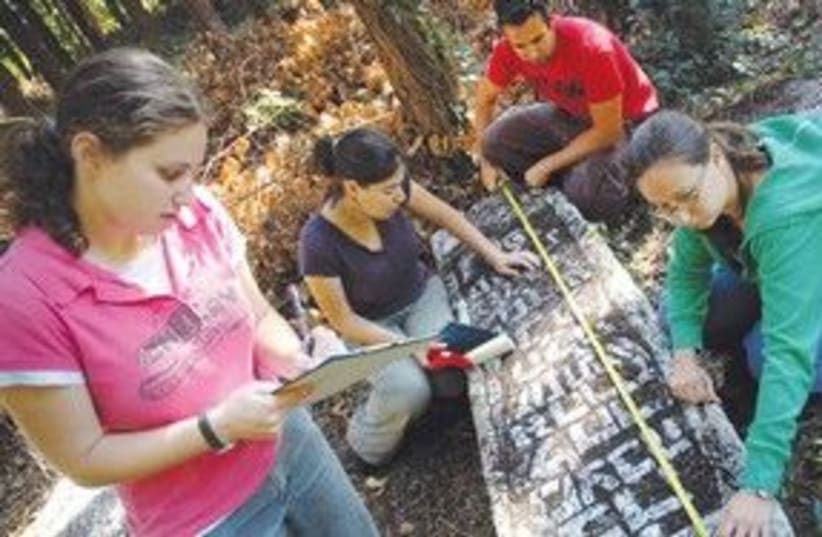RELATED:Next winter’s Journey into Jewish Heritage may be last“It’s kind of like being a Jewish Indiana Jones,” Rebecca Sullum, a Journey alum originally from Allentown, Pennsylvania, who now works as its resource development fellow, said in an interview on Tuesday. “We uncover things nobody else knows about. For instance, when I was in the Greek city of Ioanina I found a pre-Inquisition tombstone that was previously unknown.”Journey into Jewish Heritage has sent volunteer students to document Jewish communities, both extant and extinct, in locations all over the world including Mumbai, India; Izmir, Turkey; Kosice, Slovakia; and Kutaisi, Georgia, to name a few.“Our last delegation just came back from Sarajevo, which is interesting because of the civil war there,” Sullum said. “We worked on a Sephardic synagogue from 1937 built before the war, which had fallen into disuse. It was unrecognizable as a synagogue.”The program covers accommodation and living expenses for participants. Students donate their time and buy a plane tickets themselves. Besides taking part in important preservation work often recognized for academic credit, volunteers have time to make friends with their peers.“It’s kind of kitschy but there are married couples who met through our program,” Sullum said. “We only work until it gets dark so there’s plenty of time for socializing afterward. Usually there are a few members of the local Jewish community taking part so they show us around.”Sullum’s favorite memory from her own trip in 2006 was a banquet thrown by the Jews of Ioanina on the shores of a lake high in the mountains of northeastern Greece. During the feast, the remaining Jews of the city regaled their guests with stories about their community’s history, which goes back to ancient times, in between downing shots of ouzo and noshing on local cuisine.Over the next 12 months Journey into Jewish Heritage is heading to two destinations. The first project will take place in the summer in Mukachevo, southwestern Ukraine. Known in Yiddish as Munkatsh, this rustic town was once a bastion of hasidut whose streets teemed with types out of a Shoilem Aleichem novel.The second expedition scheduled to take place next winter is to the Baron Hirsch Jewish colonies in the central pampas region of Argentina, where Jewish cowboys, or gauchos, once roamed the range.“I almost wish I hadn’t gone on my own Journey trip so I could apply to this one,“ Sullum said. “Because there are no Jews left there we’ll have to work differently, interviewing people here and in Buenos Aires before we get there.”Sullum encouraged all applicants interested in joining the upcoming expeditions to visit their website (www.jewishheritage. org.il/default.aspx) and apply before the deadline on January 21.The program is open to all undergraduates in their senior year, and to students studying for their master’s and doctoral theses.
Students help save memories of lost Diaspora communities
Since 2002, Journey into Jewish Heritage has sent groups of Israeli, Diaspora students on trips to document once thriving communities.

RELATED:Next winter’s Journey into Jewish Heritage may be last“It’s kind of like being a Jewish Indiana Jones,” Rebecca Sullum, a Journey alum originally from Allentown, Pennsylvania, who now works as its resource development fellow, said in an interview on Tuesday. “We uncover things nobody else knows about. For instance, when I was in the Greek city of Ioanina I found a pre-Inquisition tombstone that was previously unknown.”Journey into Jewish Heritage has sent volunteer students to document Jewish communities, both extant and extinct, in locations all over the world including Mumbai, India; Izmir, Turkey; Kosice, Slovakia; and Kutaisi, Georgia, to name a few.“Our last delegation just came back from Sarajevo, which is interesting because of the civil war there,” Sullum said. “We worked on a Sephardic synagogue from 1937 built before the war, which had fallen into disuse. It was unrecognizable as a synagogue.”The program covers accommodation and living expenses for participants. Students donate their time and buy a plane tickets themselves. Besides taking part in important preservation work often recognized for academic credit, volunteers have time to make friends with their peers.“It’s kind of kitschy but there are married couples who met through our program,” Sullum said. “We only work until it gets dark so there’s plenty of time for socializing afterward. Usually there are a few members of the local Jewish community taking part so they show us around.”Sullum’s favorite memory from her own trip in 2006 was a banquet thrown by the Jews of Ioanina on the shores of a lake high in the mountains of northeastern Greece. During the feast, the remaining Jews of the city regaled their guests with stories about their community’s history, which goes back to ancient times, in between downing shots of ouzo and noshing on local cuisine.Over the next 12 months Journey into Jewish Heritage is heading to two destinations. The first project will take place in the summer in Mukachevo, southwestern Ukraine. Known in Yiddish as Munkatsh, this rustic town was once a bastion of hasidut whose streets teemed with types out of a Shoilem Aleichem novel.The second expedition scheduled to take place next winter is to the Baron Hirsch Jewish colonies in the central pampas region of Argentina, where Jewish cowboys, or gauchos, once roamed the range.“I almost wish I hadn’t gone on my own Journey trip so I could apply to this one,“ Sullum said. “Because there are no Jews left there we’ll have to work differently, interviewing people here and in Buenos Aires before we get there.”Sullum encouraged all applicants interested in joining the upcoming expeditions to visit their website (www.jewishheritage. org.il/default.aspx) and apply before the deadline on January 21.The program is open to all undergraduates in their senior year, and to students studying for their master’s and doctoral theses.